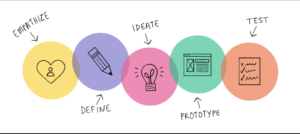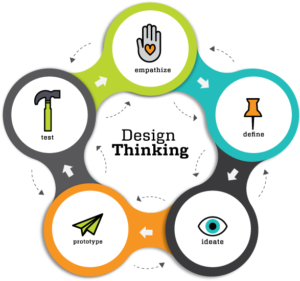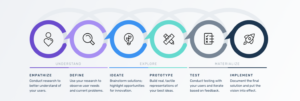2.3 Using Design Thinking and UX Principles in the Work
Johanna L. Phelps
Whether you are working on a team or individually on this project, when we consider strategies students deployed to successfully complete past projects, we see students who’ve recognized that (1) writing is an iterative process and (2) all writing is rhetorical.
Especially for large scale and research involved projects such as a community engagement project, we encourage you to recognize that it may take many drafts and revisions before you are prepared to submit materials to your professor and partner for evaluation. Second, all writing contexts are rhetorical. In your course, you’ve practiced writing several genres already. Perhaps you will use the same genres or practice with new ones. Regardless, the audience, purpose, and context of this writing experience is different from the tasks you’ve completed already. Therefore, recognizing writing as a rhetorical process saturated with choices is critical to your success. These two key ideas inform technical and professional writing efforts. Because they are commonplace in industry and academia, a number of principles have emerged to help writers succeed in all sorts of environments. This chapter introduces what we recommend you consider as you craft your materials: design thinking and UX. Whether your instructor has discussed these principles in depth or not, this section invites you to consider how these strategies can improve your final deliverables.
Design Thinking
Design thinking is one way to approach what are commonly referred to as “wicked” problems in industry. Design thinking is a framework, or methodology (like the waterfall and agile methodologies mentioned above) for approaching the work you’ll tackle in this community engagement project. Design thinking is particularly useful for a few reasons. The principles of design thinking:
- emphasize empathizing as a key first step—designers must make a concerted effort to understand the issue from the perspective of the end user and/or commissioner of the work
- honor the variability and “humanness” of working within a social space, such as the one you’ll encounter in this community engagement project.
- represents an interactive process for ideating, prototyping, and testing

You can read more about design thinking here:
- Design Thinking by the Interaction Design Foundation
- Design Thinking Defined by Ideo
- Design Thinking Process by Stephanie Baseman
- Buchanan’s famous article Wicked Problems in Design Thinking
- Buchanan, R. (1992). Wicked problems in design thinking. Design issues, 8(2), 5-21.
Design thinking is pertinent because it provides space for failing forward, assessing prototypes and revising with key audiences in mind. Community engagement projects can be complex and even be left unfinished at the end of a semester, with the intent for your work to be picked up by another team next semester. Therefore, consider if any of the following visuals may help you better understand a process for this work. Do any of these represent a process you can envision working through during this community engagement project?

From Iain Heath’s post on the UX Collective “User experience is…design thinking”


Stephanie Baseman’s visualization
Design thinking is one way of consolidating the rhetorical and iterative components of a consequential community engagement project. Since your final materials are to be shared with partners outside of the course and perhaps put to use in the community, it’s critical to recognize that your work is a component of a larger initiative. This framework can hopefully minimize the stress of the project, and also helps you recognize how critical it is to appropriately situate your work (and empathize) with your end users.
UX
UX is the shorthand for user experience and considerations of UX are a natural result of successful design thinking. User experience is in fact a much broader term that refers to a whole suite of experiences one individual may have with, for example, a company—from browsing their website, ordering materials, working with their customer service, and/or receiving promotional materials. In our context, though, we want to think of user experience on a bit of a “micro” scale. Let’s think of UX as a term that refers to the end users’—or primary audience of a text or set of materials—(future) experience(s) with the materials you’re developing.
It is important to understand that in a capacity-building community engagement project, your end user is rarely the clients of the organization or your professor. Instead, they are likely the folks who manage the organizational infrastructure of the organization. If you are proposing a house style guide, or a set of HR materials for hiring and termination, your end user is the individuals who will be using those materials, and a secondary audience is the individuals who will be impacted by the use of those materials. Effectively recognizing the multiple audiences of your materials will ensure you can take UX concerns into account. Some strategies you can use are the audience planner and McMarry’s chapter on audience.
Recognizing who is/will be the end user of any sort of technical documentation or tool is critical to ensuring the successful uptake of that material.You can read more about user experience and experience architecture here:
- User Experience Basics at usability.gov
- The Definition of User Experience at Nielson Norman Group
- UX Design at the Interaction Design Foundation
UX considerations encompass many of the rhetorical components of audience analysis and also provide strategies for assessing the user experience of materials. Your instructor and/or partner may also ask you to conduct usability assessments on the materials you are developing, too. We’ll talk more about UX, usability, and audience in the first section of Chapter Three. Before you begin your research and development work in earnest, reflect on the following questions to get your wheels turning on next steps. Take a moment and reflect on the end user of your materials (your primary audience):
- What are your end users’ general characteristics?
- What tools or fiscal resources must they have at their disposal to successfully deploy your strategies/recommendations?
- What expectations about technical proficiencies, hardware, software, training are required for a user of your proposed materials?
- What sustainability strategies are built into the materials so they can be repurposed and/or used in future years?
